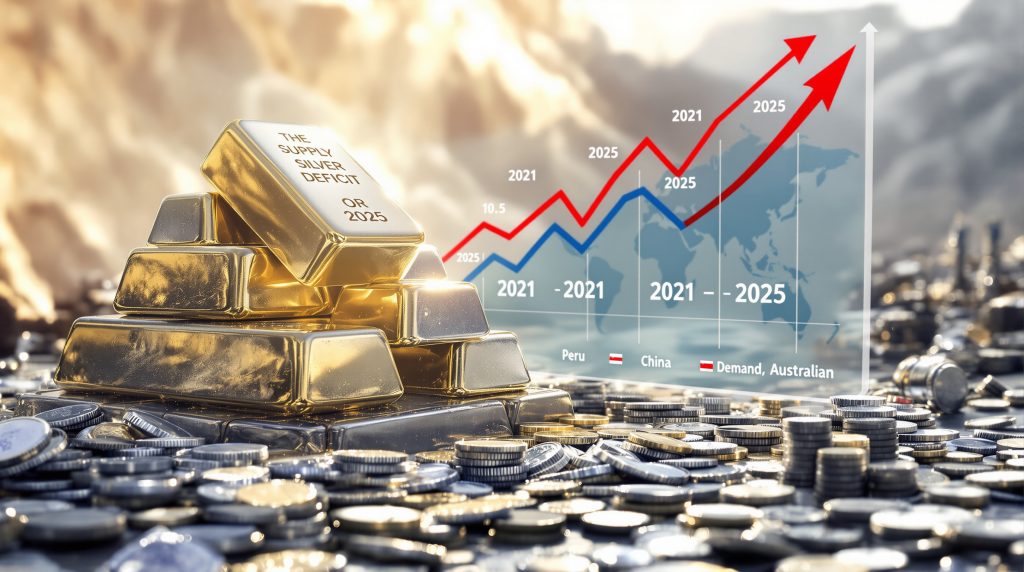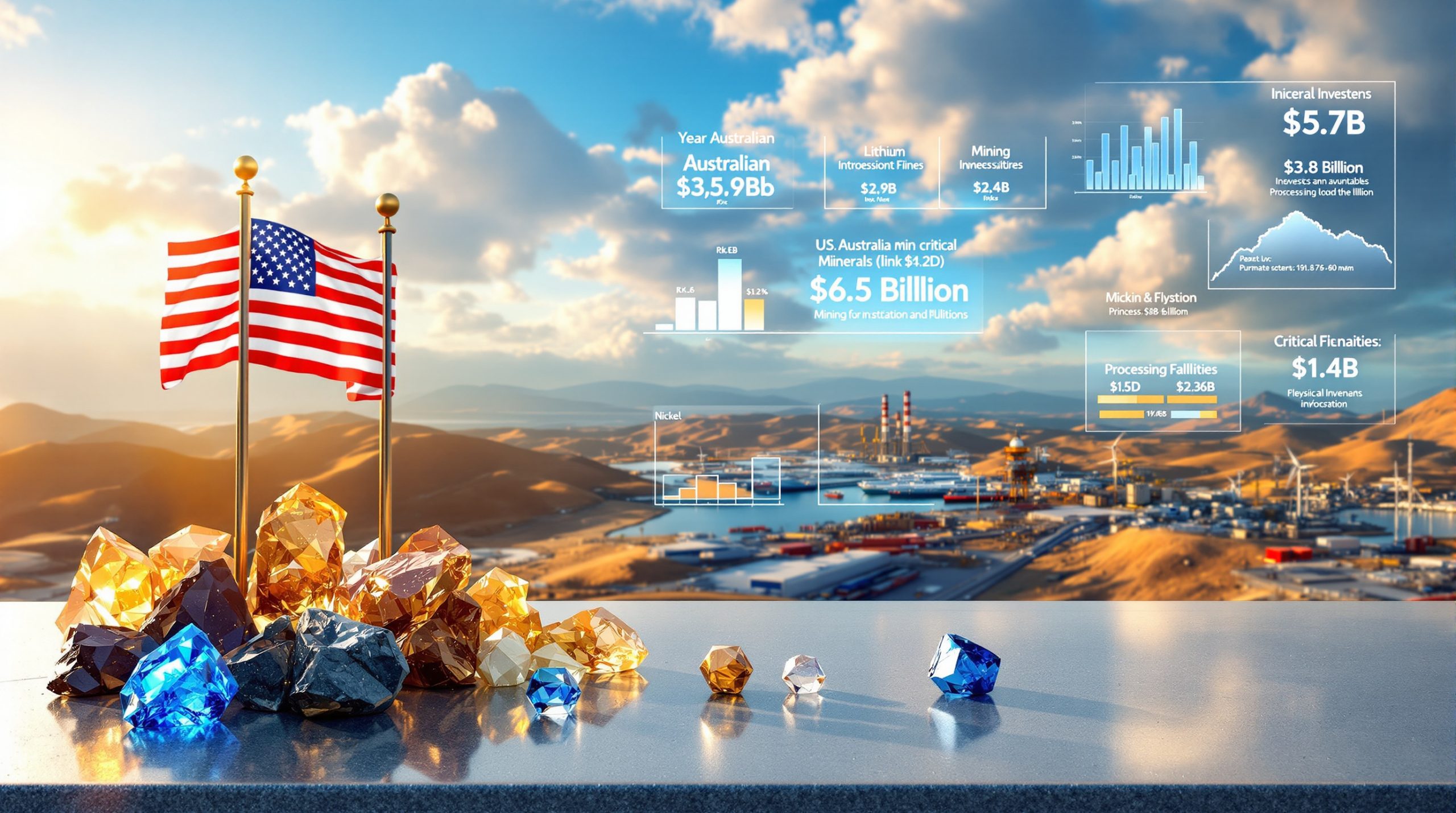The Physical Silver Shortage: A Market Under Extreme Pressure
The global silver market is experiencing unprecedented pressure from both supply constraints and surging demand. What we're seeing isn't just a temporary market anomaly but rather a structural deficit that has been building for years and is now reaching critical levels. The interplay between limited production capacity and growing consumption across multiple sectors has created a perfect storm for physical silver shortage.
What's Causing the Current Physical Silver Shortage?
The current physical silver shortage stems from a combination of supply-side limitations colliding with rapidly expanding demand across multiple sectors. This imbalance has been developing over several years but has recently accelerated.
Supply-Side Constraints Creating Bottlenecks
The silver supply chain faces multiple structural challenges that severely limit production flexibility:
-
Byproduct Dependency: Approximately 70% of newly mined silver comes as a byproduct from mining other metals (copper, lead, zinc, gold), making silver supply relatively inelastic to silver price signals. This means that even significant price increases don't necessarily trigger proportional production increases.
-
Declining Ore Grades: Existing mines are yielding less silver per ton of processed material, requiring more energy and resources to produce the same amount of metal.
-
Exploration Deficit: A decade of underinvestment in new silver projects has created a development pipeline gap. According to mining industry studies, new precious metal mines typically require 7-15 years from discovery to production.
-
Regulatory Hurdles: Environmental permits and social license challenges have extended mine development timelines to 7-10 years in many jurisdictions.
-
Production Costs: Rising energy, labor, and equipment expenses have squeezed profit margins for producers, discouraging expansion even as prices rise.
Demand Surge Across Multiple Sectors
While supply remains constrained, demand has accelerated dramatically across various industries:
-
Industrial Applications: Manufacturing sectors now consume over 50% of annual silver production, with many of these applications allowing minimal substitution.
-
Green Energy Transition: Solar panel production alone accounts for approximately 140 million ounces of silver annually, with requirements increasing as global solar capacity expands.
-
Electronics Revolution: 5G infrastructure, electric vehicles, and consumer electronics create persistent demand for silver's unmatched electrical conductivity properties.
-
Investment Demand: Physical silver purchases through coins, bars, and ETFs have surged as inflation concerns mount.
-
Medical and Specialized Uses: Silver's antimicrobial properties drive demand in healthcare applications, particularly following global health concerns.
How Severe is the Current Silver Deficit?
The silver market has shifted from historical surpluses to persistent silver supply deficits, with the imbalance growing more severe each year.
Quantifying the Market Imbalance
According to the Silver Institute, the silver market showed a deficit of approximately 184.3 million ounces in 2023. This continues a multi-year trend of consumption exceeding production:
| Year | Estimated Deficit (Million Ounces) | % of Total Market |
|---|---|---|
| 2020 | 81 | ~8% |
| 2021 | 51 | ~5% |
| 2022 | 142 | ~15% |
| 2023 | 184 | ~20% |
| 2024 | 200+ (estimated) | ~22% |
These consecutive deficits represent a fundamental shift in market dynamics, depleting above-ground inventories that previously cushioned supply disruptions.
Inventory Depletion Reaching Critical Levels
The ongoing deficit has systematically drained available inventories across the market:
-
Exchange Inventories: COMEX registered silver stocks have fallen to multi-year lows, constraining market liquidity.
-
Industrial Stockpiles: Manufacturers have depleted safety stocks to maintain production schedules, increasing vulnerability to supply chain disruptions.
-
Investment Holdings: ETF outflows have temporarily masked physical tightness but cannot continue indefinitely.
-
Refinery Bottlenecks: Processing capacity constraints limit the rapid conversion of mine output to market-ready products, creating delivery delays.
This systematic drawdown of inventories means the market has increasingly limited buffers against supply disruptions or demand spikes.
What Market Signals Indicate Extreme Tightness?
Several key technical indicators point toward unprecedented tightness in physical silver markets.
Backwardation: The Ultimate Shortage Signal
The silver market is showing classic signs of physical shortage through its price structure:
-
Backwardation Definition: Backwardation occurs when spot prices exceed futures prices, typically indicating physical market tightness. This is unusual for storable commodities and signals immediate delivery demand.
-
Lease Rate Increases: Silver lease rates have surged significantly, indicating extreme borrowing pressure as holders of physical metal can demand premium returns for lending it.
-
Delivery Delays: Physical silver deliveries face extended wait times from major dealers, with premium products often on allocation.
-
Premium Expansion: Retail premiums on silver products have widened significantly above spot prices, particularly for smaller denomination products.
-
ETF Disconnect: Silver ETF holdings have remained relatively flat despite price increases, suggesting limited physical availability for creation units.
Technical Market Indicators
Several technical signals confirm the physical shortage:
-
Price Volatility: Increased day-to-day price swings reflect market uncertainty and tight supply conditions.
-
Volume Patterns: Trading volumes spike during price increases rather than decreases, indicating accumulation rather than distribution.
-
Open Interest: Fluctuating futures market open interest despite rising prices indicates complex positioning adjustments.
-
Spread Behavior: Narrowing spreads between different delivery months signal immediate demand pressure.
Market Analysis Note: When physical commodities markets experience backwardation alongside rising lease rates, it historically signals significant supply constraints that typically resolve through higher prices.
Why Can't Mining Supply Respond Quickly?
The silver mining industry faces substantial structural limitations that prevent rapid supply increases even with strong price signals.
Structural Limitations to Supply Response
Even with silver prices at multi-year highs, supply cannot rapidly expand due to:
-
Development Timelines: New mines require 5-10 years from discovery to production, with complex permitting, construction, and commissioning phases.
-
Capital Requirements: Major silver mining projects typically require $200 million to over $1 billion in development capital, creating significant financing barriers.
-
Byproduct Economics: When silver is a byproduct, production decisions are based primarily on the economics of the main metal (copper, lead, zinc), limiting supply responsiveness.
-
Resource Nationalism: Government policies in key producing regions like Mexico and Peru create uncertainty through changing royalty structures and permitting requirements.
-
Grade Decline: Existing operations face diminishing returns as they mine deeper or process lower-grade ore, requiring more material processing for the same silver output.
Geographic Concentration Risks
Silver production is highly concentrated geographically, creating systemic vulnerability:
-
Top Producers: According to the Silver Institute, Mexico, Peru, China, Chile, and Poland account for approximately 60% of global mine silver production.
-
Political Risks: Labor disputes, regulatory changes, and resource nationalism threaten stable supply from these regions.
-
Infrastructure Limitations: Power, water, and transportation constraints in remote mining regions limit expansion potential.
-
Processing Bottlenecks: Refining capacity hasn't expanded in proportion to demand, creating processing constraints.
How Are Industrial Users Responding to the Shortage?
Industries dependent on silver are implementing various strategies to manage supply risks and rising costs.
Strategic Adaptations by Manufacturers
Manufacturers across sectors are adjusting to the new reality of silver scarcity:
-
Inventory Building: Critical industries are attempting to secure longer-term supplies through strategic stockpiling, forward contracts, and direct mine partnerships.
-
Thrifting: Manufacturers are reducing silver content where technically feasible, though this often comes with performance trade-offs.
-
Price Pass-Through: Increasing component costs are being passed to consumers, though competitive pressures limit this strategy in some sectors.
-
Supply Chain Diversification: Companies are seeking multiple sources to reduce dependency on single regions or suppliers.
-
Recycling Emphasis: Greater focus on recovering silver from end-of-life products has emerged, with improved recycling technologies.
Impact on Green Energy Transition
The silver shortage has particular implications for renewable energy expansion:
-
Solar Panel Costs: PV manufacturers face input cost pressures despite efficiency improvements, potentially slowing cost reductions.
-
Production Scheduling: Panel production timelines extend due to material availability issues, affecting project completion dates.
-
Innovation Pressure: Accelerated research into silver alternatives or reduced-silver designs is underway, though performance trade-offs remain.
-
Strategic Stockpiling: Major manufacturers are securing long-term supply agreements to ensure production continuity.
What Does This Mean for Silver Prices?
The physical shortage is forcing a fundamental repricing of silver across global markets.
Price Discovery in a Constrained Market
The silver market is undergoing a significant transition in how prices are determined:
-
Paper vs. Physical Divergence: Growing spread between paper silver contracts and physical delivery prices reflects delivery risk premiums.
-
Price Volatility: Increased day-to-day price movements occur as market participants adjust positions in a tightening market.
-
Upward Pressure: Structural deficits typically resolve through higher prices that either stimulate supply or destroy demand, with the former taking years to materialize.
-
Industrial Priority: Essential industrial users are outbidding investment demand for available supply, creating sector-specific premiums.
Historical Context for Current Price Movements
Current price action can be understood through historical parallels:
-
1970s Comparison: Similar supply/demand imbalances in the 1970s led to dramatic price increases before new production eventually responded.
-
2011 Peak vs. Today: Today's fundamentals appear stronger than during the previous price peak, with more diverse industrial demand and continued monetary uncertainty.
-
Inflation-Adjusted Potential: In real terms, silver remains below historical highs when adjusted for inflation, suggesting potential upside remains.
How Are Investors Positioning for the Silver Shortage?
Investors are adopting various approaches to navigate and potentially benefit from the silver squeeze analysis.
Investment Strategies in a Tight Market
Investors are implementing diverse strategies based on their risk tolerance and market outlook:
-
Physical Allocation: Direct ownership of coins and bars provides maximum security with no counterparty risk, though storage considerations apply.
-
Strategic ETFs: Fully-allocated ETFs with transparent auditing processes offer convenience while attempting to minimize counterparty risk.
-
Mining Equities: Companies with primary silver production and strong balance sheets offer operational leverage to rising prices.
-
Royalty Companies: Exposure to silver production without direct operational risks provides a hybrid investment approach.
-
Options Strategies: Leveraged exposure through call options on silver futures or ETFs appeals to those with higher risk tolerance.
Risks and Considerations
Investors should be aware of several factors when implementing silver pricing strategies:
-
Volatility Risk: Silver prices can experience sharp corrections even in bull markets, requiring appropriate position sizing.
-
Counterparty Concerns: Paper silver products may face delivery challenges in extreme shortages, highlighting the importance of understanding redemption mechanisms.
-
Storage Considerations: Physical silver requires secure storage solutions, with associated costs and logistics.
-
Premium Fluctuations: Retail premiums can significantly affect realized returns, particularly for smaller products.
-
Tax Implications: Different silver investment vehicles have varying tax treatments that should be considered in investment planning.
What Could Resolve the Silver Shortage?
Several developments could eventually alleviate the current shortage, though each has different timeframes and probabilities.
Potential Pathways to Market Balance
Several developments could eventually alleviate the current shortage:
-
Price-Induced Demand Destruction: Sufficiently high prices could reduce discretionary industrial use and consumer demand for silver-intensive products.
-
Technological Substitution: Accelerated development of silver alternatives in less critical applications could reduce consumption in some sectors.
-
Recycling Expansion: Higher prices incentivize greater recovery from industrial and consumer waste, creating a secondary supply source.
-
New Production: Long-term price signals eventually bring new mines online, though with multi-year development timelines.
-
Macroeconomic Shifts: Economic slowdown could temporarily reduce industrial demand, though monetary demand might simultaneously increase.
Timeline Considerations
Market participants should understand the likely timeline for resolution:
-
Short-Term (0-12 months): Continued tightness with premium expansion and volatility as existing inventories deplete further.
-
Medium-Term (1-3 years): Gradual supply response through existing mine expansion and recycling improvements begins to address deficits.
-
Long-Term (3+ years): New mine development potentially bringing market toward balance, though structural demand growth continues.
FAQ: Understanding the Physical Silver Shortage
How does the silver shortage affect ordinary consumers?
The silver shortage impacts consumers through higher prices for electronics, jewelry, and solar installations. Products containing significant silver may face longer lead times or redesigns to reduce silver content. Investment-grade silver products like coins and small bars typically see premium increases during shortages, affecting accessibility for retail investors.
Is silver becoming "unobtainable" for average investors?
While premiums have increased and delivery times extended, silver remains available to retail investors through established dealers. However, quantity restrictions may apply during periods of extreme demand, and investors should expect to pay higher premiums over spot prices. Many dealers implement allocation systems rather than completely running out of inventory.
How does the silver shortage compare to other metals markets?
Unlike many industrial metals that can rapidly increase production with higher prices, silver's byproduct status makes supply relatively inelastic. The shortage more closely resembles precious metals markets like platinum or palladium, where structural deficits can persist for extended periods before new mining projects eventually respond.
Could governments intervene in the silver market?
Historical precedent exists for government intervention in precious metals markets. During periods of extreme price movements, authorities might implement position limits, margin requirements, or even trading suspensions. Strategic reserves could theoretically be released, though few countries maintain significant silver stockpiles today compared to gold reserves.
How reliable are silver market data and deficit projections?
Silver market transparency has improved but remains imperfect. Production data from major mining companies is generally reliable, but inventory levels, especially in non-transparent markets like China, are less certain. Deficit projections should be viewed as informed estimates rather than precise measurements, with particular attention to methodology and assumptions.
Silver's Dual Nature: Industrial Metal and Monetary Asset
Silver's unique position as both an industrial commodity and a monetary metal creates complex market dynamics during shortage periods.
Industrial Necessity vs. Monetary Insurance
Silver serves two distinct functions in the global economy:
-
Critical Industrial Component: Silver's electrical conductivity, thermal properties, and antimicrobial characteristics make it irreplaceable in many high-tech applications.
-
Monetary Asset and Inflation Hedge: Silver's 5,000-year history as money and its relative scarcity maintain its role as a store of value during monetary uncertainty.
This dual nature means silver demand can surge from both sectors simultaneously during periods of industrial growth and monetary instability, amplifying silver market crash causes.
The Long-Term Outlook
The physical silver shortage represents a fundamental realignment of a market that has been artificially suppressed through paper trading mechanisms for decades. As physical demand overwhelms financial market constructs, price discovery shifts from derivative markets to the actual cost of securing physical metal.
For long-term investors, understanding this transition is crucial. While price volatility will certainly continue, the structural deficit suggests a market in the early stages of a significant repricing as decades of underinvestment in production capacity collide with accelerating demand across multiple growth industries.
Disclaimer: This analysis reflects current market conditions and should not be considered investment advice. All investments carry risk, and past performance is not indicative of future results. Readers should conduct their own research and consult with financial advisors before making investment decisions.
Are You Monitoring the Next Major Silver Discovery?
Discover significant ASX silver exploration announcements as they happen through Discovery Alert's proprietary Discovery IQ model, which instantly transforms complex mining data into actionable investment insights. Visit our discoveries page to understand how major mineral discoveries can generate substantial market returns and begin your 30-day free trial today.




